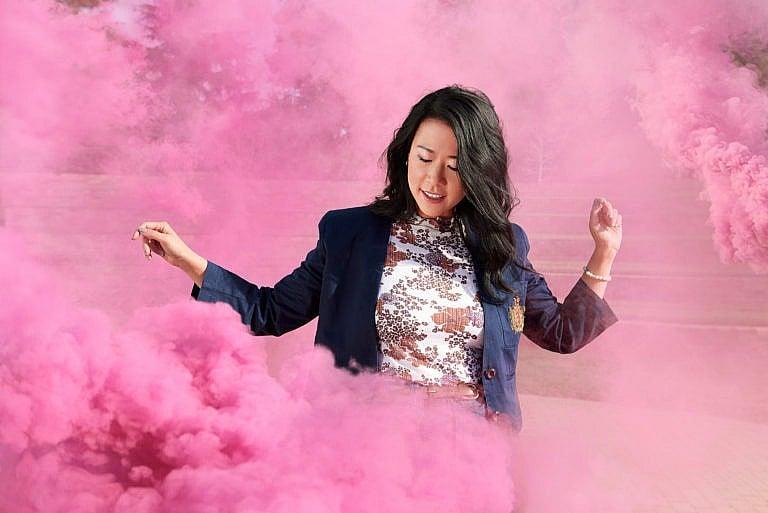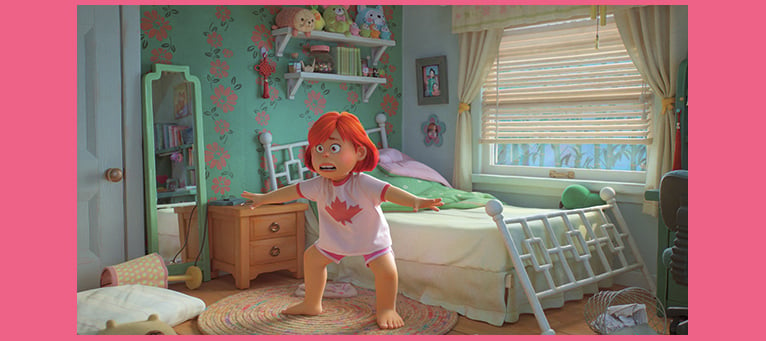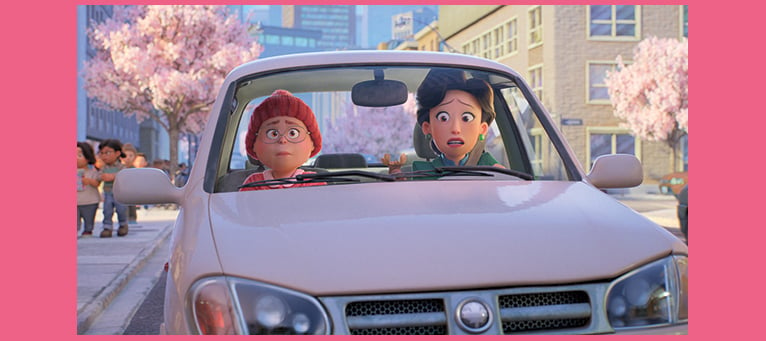With ‘Turning Red,’ Domee Shi wants to tell the story of your childhood
The Canadian director won an Oscar for her touching Pixar short. Now, in her debut feature, she plumbs her childhood to make a movie for everyone.

(Photograph by Jessica Chou)
Share
There’s a scene in Turning Red, the upcoming Pixar movie directed by Canadian wunderkind Domee Shi, that had me guffawing in bed. Mei, the 13-year-old protagonist, begins sketching a boy on the pages of her math homework when she realizes she’s drawing the likeness of Devon, a 17-year-old boy who works at the local Daisy Mart in Toronto’s Chinatown, where she lives.
Mei’s right brain takes over, her hand unable to pull away from the paper—Devon’s got chiselled shoulders; Devon winks at her and a heart floats from his eye; he’s embracing her now. Mei realizes what she’s drawing, and she’s giddy. Her eyes grow wide and her cheeks flush red. Then Mei’s mom, Ming, voiced by Canadian actress Sandra Oh, walks into her room. Mei shoves the sketchpad under her bed, but the corner of it pokes out. It’s a matter of seconds before her mom opens the book and sees the drawings inside.
This is my life, I think, recalling a time in high school when my mom went through my backpack and found condoms inside. “I got them for free! At a clinic!” I yelled as she grabbed a handful and threw them in the bin.
Like Mei, whose story is loosely based on Shi’s family, I’m the only daughter of immigrant Asian parents. I grew up in Toronto, in an apartment just walking distance from where Shi lived. I was born two years ahead of her, in 1987, but we lived somewhat parallel lives, taking the TTC to school and asserting our tween independence while trying to pacify our overly concerned mothers.
Mei, who turns into a giant red panda every time she experiences intense emotion, might feel familiar to millennials who came of age in the early 2000s; it’s a film that brings us back to the days when we belted Britney Spears’s lyrics “Hit me baby one more time” and plastered Justin Timberlake’s bleached, spiky hair-framed face across our bedroom walls.
But there’s another layer to the movie that makes it feel like it’s mine. Shi doesn’t just create a story about parental expectation as it conflicts with the child’s own wants and dreams, a stereotype reverted to by many Western films depicting Chinese families (think Crazy Rich Asians). Instead, by drawing on her own life, and her own relationship with her parents, she portrays a family dynamic that isn’t “Asian,” per se, but ordinary: challenging, rewarding, messy and full of both tenderness and regret.
“Did you ever think that your relationship with your parents would be . . . ” I ask the first time I speak with Shi over Zoom, in late December. “My life’s work?” Shi says, smiling.
***
In many ways, Mei’s mother, Ming, is your typical “tiger mom”: she expects excellence from Mei across academics, extracurriculars and at home; she’s not afraid to tell Mei if she thinks one of her friends is “odd”; and she has no problem showing up at Mei’s school unannounced, regardless of how that might make Mei feel.
Tiger moms, who adopt a style of parenting that’s generally authoritarian—demanding, overprotective, emotionally unsupportive—were first so called by Chinese-American law professor and author Amy Chua, who wrote the 2011 memoir Battle Hymn of the Tiger Mother. The expression has since been adopted by the American Psychological Association and referenced widely across North American media and pop culture.
“There’s a sense from the trailer that [Ming] is a tiger mom, but I’m also just like, she’s a pretty nice mom,” says Adrian De Leon, a Filipino professor from Toronto who teaches American studies and ethnicity at the University of Southern California. “There is going to be a lot of temptation, especially from audiences, to try to fit [this movie] into an Orientalist perspective to figure out what is quintessentially Asian about it, when actually what is so quintessentially Asian about the story is that it is so normal.”

Becky Neiman-Cobb, left, and Domee Shi, Oscar winners of the best animated short, "Bao," during the Governors Ball Oscars after-party in Los Angeles, Feb. 24, 2019. (Patrick T. Fallon/The New York Times/Redux)
Shi reflected on the relationship with her own mother, Ningsha, through the eight-minute short Bao; Shi’s directorial debut for Pixar, it won the 2019 Academy Award for best animated short film. The plot line centres on a Chinese mother who grieves her only son’s departure from home. As the mother grapples with the concept of an empty nest, one of her handmade dumplings comes to life and becomes her fantasy son, until he grows up too. In the end, the mother swallows her dumpling so he’ll never have the chance to leave.
Turning Red looks at the parent-child relationship from the kid’s point of view. “When I was younger, I was like, ‘Why are my parents so unfair? Why are they so crazy and overprotective?’ ” Shi says. “It just comes from wanting to protect your kid and the experiences my mom went through when she was younger in coming to a new country, and having this only child who could be taken away at any moment by the forces of the universe.”
In 1990, when Shi was just one, Ningsha left Chongqing, a city in China’s Sichuan province, to pursue a master’s in humanities at Memorial University in Newfoundland. Shi and her dad, Le, followed a year later and the family lived in St. John’s before moving to Toronto in 1993, when Ningsha was offered a spot in the Ph.D. program in education at the University of Toronto.
Ningsha says Shi was a quiet child who loved eating home-cooked pork, chive and cabbage dumplings, and Sichuan staples like mapo tofu and Chongqing hot pot. She also loved sketching. At night, she’d spend three or four hours lying on her stomach and drawing, with reruns of CSI or The Simpsons on in the background. Le, a landscape painter and fine art teacher, taught Shi basic technique and scale early on “for fun,” he says. When he’d nudge her to go to bed, she’d say “I’m just finishing this one, Dad.”
Ningsha says she was a “strict” mother, ceaselessly concerned about her only daughter’s safety and progress. She needed to be physically close to Shi most of the time, even if that meant transferring Shi from a middle school close to their home in East York to one that was right across the street from her office downtown.
A scene in Turning Red, where Ming shows up at the window outside of Mei’s math class and gets into a fight with the school’s security guard, is based on Shi’s first day of middle school: “[My mother] was hiding behind a tree with sunglasses on when I came out of school with my new friends,” Shi remembers. “I was mortified.”
Shi took it all in stride and never lashed out, even when the pressures of toggling between extracurriculars—like practising the flute for at least seven hours a week (she completed her Grade 10 Royal Conservatory of Music exams), academics, art—and just being a teen began to collide. Shi thought of quitting music “all the time,” she says. And Ningsha could see that her daughter was close to the breaking point, but never said a word. “We don’t talk,” Ningsha says . “We just feel.”
***
Ningsha and Le shuffle around to try and get both their faces in the frame. They’re in the kitchen, talking to me on Zoom from their bungalow in Scarborough, Ont., where the family has lived since 2003.
Le lifts a stack of at least six sketchbooks so I can see them. Ningsha, who has a round face and kind eyes, looks eerily similar to the mother in Bao. Le is quiet, and chooses his words carefully, similar to Mei’s father in Turning Red. As parents, they never pushed Shi toward a specific profession, he says, but he did warn about the financial pitfalls of art as a career: “If you choose art,” he said to her, “that means you’re poor.” So if she was going to do it, she’d better be exceptional.
After high school, Shi pitched Sheridan College’s world-renowned animation program to her parents as the perfect mix of art and commercialism. Nancy Beiman, Shi’s second-year storyboard teacher and a Disney animation vet who has worked on characters like Bugs Bunny, Goofy and Hercules, says that Shi displayed film sensibility early on.
A storyboard is like a comic strip, but for a movie. “You are portraying the performance of the character,” says Beiman. “You are not doing all the animation, you’re only doing the important acting bits—a visual shorthand for a script.”
Shi’s very first assignment was to create a storyboard to match “Hector Protector,” a children’s nursery rhyme. “[Shi] did an arrow shooting off of different parts of the castle, taking off people’s wigs and knocking them off their thrones,” Beiman says. “Whereas a lot of people would stage it flat, she had all sorts of camera angles.”
Shi’s love of reading comics—Garfield, Betty and Veronica and One Piece, a Japanese manga series by Eiichiro Oda—gave her an edge, along with her ability to inject dark elements into what would be considered lighthearted themes. In 2018, she told the Los Angeles Times that Bao’s macabre ending came from “that primal feeling of just wanting to love something so much that you’re willing to destroy it.”
Ayan Sengupta, a television animator and Shi’s former classmate at Sheridan, recalls a third-year group film project for which Shi pitched and boarded the entire film in two days, a process that would normally take over a month. And when they were asked to make a film by themselves as a final project in fourth year, Shi’s boards were the movie: “Like, you could just play her drawings on the screen, and you wouldn’t even have to animate or add colour or anything—the board would look like a film,” he says.
In January, Disney, which owns Pixar, held a virtual press event ahead of Turning Red’s March release. One of the film’s animators, Aaron Hartline, showed a few slides of Shi’s black-and-white hand-drawn boards depicting Panda Mei’s expressions beside stills of Panda Mei from the film: “I myself witnessed how Domee carefully figured out the entire film down to just the right expression,” he said. “So whenever possible, we follow those specific quirky poses and put them into our characters . . . those drawings are gold for the animators to follow.”
***
In 2021, when North Americans once again encountered a rise in anti-Asian hate crimes as a repercussion of the global COVID-19 pandemic, celebrities, artists and activists rallied around the campaign #StopAsianHate, which snowballed on social media. Asians across North America reckoned with the reality that the violence was only one manifestation of anti-Asian racism.
The “model minority” narrative, which surfaced after the Second World War, stemmed from the belief that Asians were the ideal people of colour to emigrate to the United States due to their potential economic success. The outcome has been a prejudice that’s reverberated in everything from the way Asians are hired in the workforce (tokenism) to the way we are portrayed in film and television.
RELATED: Tanya Talaga is telling the stories Canada needs to hear
“So much of racism, especially in the arts, is that stories about us are imagined by other people,” De Leon says,“that we do not have the agency and the capacity to not only imagine stories and be storytellers in our own right, but for that work to be considered on its own terms.”
De Leon refers to Bling Empire, a Netflix series that follows the life and friendships of Kevin Kreider, a Korean-American model who lives in Los Angeles, as one of his favourite “himbo”—slang for an attractive but not necessarily intellectual dude—stories. “There’s a certain power in not having to be this . . . ultra-smart, ultra-wealthy, ultra-hard-working Asian person,” he says. “We do have the right to just lounge around, work out and look hot.”
At the virtual publicity event for Turning Red, Shi was asked about the school security guard in the film, apparently Pixar’s first-ever turban-wearing Sikh character. “There’s quite a prominent Sikh population in Canada . . . the leader of the NDP Party, he’s Sikh,” Shi said. “And growing up, I was exposed to a lot of Sikh people in my classroom . . . the specific Sikh security guard was inspired by [Baltej Singh Dhillon] the first [turban-wearing] Royal [Canadian] Mounted Police officer.”
Sengupta, who is originally from India, is elated to see different Asian cultures interacting in film and television exactly the way they would in a city like Toronto. He believes that Canadians are leading the charge—with shows like Kim’s Convenience and Run the Burbs—in giving audiences a glimpse of the diaspora here, where Chinese, Koreans, Filipinos, Japanese, Indians, Pakistanis, Sri Lankans, Tamils, Vietnamese and Indonesians are friends, neighbours, classmates and co-workers. “Representation is key,” he says. “The only thing [that] represent[ed] [me] were the brown villains in movies, like Raza in the original Iron Man.”
When I ask Shi whether she thinks Mei could be viewed as a model minority, she shakes her head. “I don’t think so,” she says. “She’s so funny and dorky,” as if to say, can’t Mei be just that?
Spot the Canadiana
(Click through this gallery. Story continues below.)
***
Ningsha and Le haven’t seen Turning Red yet, but they both smile when I tell them their daughter credits her relationship with her parents as the throughline of her work.
I ask them to think about how she got there; what defined her as a child. Art, music and friends, they say. “Hard work” is a term Le uses often. Ningsha, on the other hand, has an urge to express regret. She remembers the time in middle school when Shi flunked her Grade 10 flute exam and had to take it a second time. “If she said, ‘I quit,’ I think about how that would have been okay. But she never said, ‘I’ll stop,’ and I never said, ‘You can stop now.’ ”
Turns out Shi always wants to finish what she starts: “I’m a completionist,” she says. “I think my mom is too.” When I ask how her relationship with her mom is reflected in Turning Red, she offers up a spoiler: “The red panda magic is actually something that Mei inherited from her mom, and the way that her mom has handled [it] is very different than how Mei wants to handle it. You see the difference between the two generations and how they deal with all of the messiness that’s inside of them.”
The Shi family is like most; there are things you don’t reveal to each other. At the press event, Shi tells the media there’s definitely a secret notebook somewhere in her room back in Canada, which she hopes her parents never see. In our interview, she tells me about asking a cousin who was visiting her parents in Toronto: “Can you take it and just burn it? Throw it away?”
Over Zoom, Le quickly flips through one of Shi’s sketchbooks and stops to show me a drawing. “Handsome boy,” he points out, as I take in the big, star-like anime eyes. The sketchbooks aren’t secret—her parents have seen them all.
This article appears in print in the March 2022 issue of Maclean’s magazine with the headline, “The magic of Domee Shi.” Subscribe to the monthly print magazine here.


